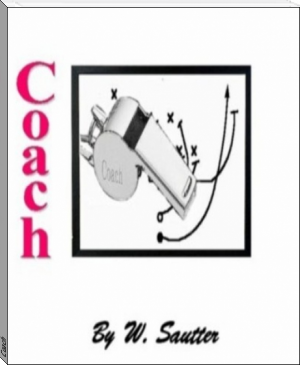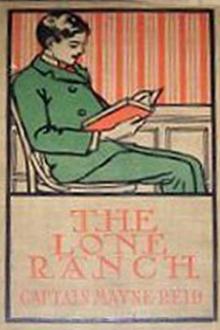The Young Voyageurs: Boy Hunters in the North, Mayne Reid [some good books to read .txt] 📗

- Author: Mayne Reid
Book online «The Young Voyageurs: Boy Hunters in the North, Mayne Reid [some good books to read .txt] 📗». Author Mayne Reid
Lucien now pointed out to his companions a characteristic of the hawk and buzzard tribe, by which these birds can always be distinguished from the true falcon. That peculiarity lay in the manner of seizing their prey. The former skim forward upon it sideways—that is, in a horizontal or diagonal direction, and pick it up in passing; while the true falcons—as the merlin, the peregrine, the gerfalcon, and the great eagle-falcons—shoot down upon their prey perpendicularly like an arrow, or a piece of falling lead.
He pointed out, moreover, how the structure of the different kinds of preying birds, such as the size and form of the wings and tail, as well as other parts, were in each kind adapted to its peculiar mode of pursuing its prey; and then there arose a discussion as to whether this adaptation should be considered a cause or an effect. Lucien succeeded in convincing his companions that the structure was the effect and not the cause of the habit, for the young naturalist was a firm believer in the changing and progressive system of nature.
Two days after the adventure with the blaireau, the young voyageurs arrived at Cumberland House—one of the most celebrated posts of the Hudson’s Bay Company. The chief factor, who resided there, was a friend of Norman’s father, and of course the youths were received with the warmest hospitality, and entertained during their stay in the best manner the place afforded. They did not make a long stay, however, as they wished to complete their journey before the winter should set in, when canoe-travelling would become impossible. During winter, not only the lakes, but the most rapid rivers of these Northern regions, become frozen up, and remain so for many months. Nearly the whole surface of the earth is buried under deep snow, and travelling can only be done with snow-shoes, or with sledges drawn by dogs. These are the modes practised by the Indians, the Esquimaux, and the few white traders and trappers who have occasion in winter to pass from one point to another of that icy and desolate region.
Travelling under such circumstances is not only difficult and laborious, but is extremely perilous. Food cannot always be obtained—supplies fall short, or become exhausted—game is scarce, or cannot be found at all, as at that season many of the quadrupeds and most of the birds have forsaken the country, and migrated to the South—and whole parties of travellers—even Indians, who can eat anything living or dead, roast or raw—often perish from hunger.
Our travellers were well acquainted with these facts; and being anxious, therefore, to get to the end of their journey before the winter should come down upon them, made all haste to proceed. Of course they obtained a new “outfit” at the Fort; but they took with them only such articles as were absolutely necessary, as they had many portages to make before they could reach the waters of the Mackenzie River. As it required two of the party to carry the canoe, with a few little things besides, all the baggage was comprised in such loads as the others could manage; and of course that was not a great deal, for François was but a lad, and Lucien was far from being in robust health. A light axe, a few cooking utensils, with a small stock of provisions, and of course their guns, formed the bulk of their loads.
After leaving the Fort they kept for several days’ journey up the Saskatchewan. They then took leave of that river, and ascended a small stream that emptied into it from the north. Making their first portage over a “divide,” they reached another small stream that ran in quite a different direction, emptying itself into one of the branches of the Mississippi, or Churchill River. Following this in a north-westerly course, and making numerous other portages, they reached Lake La Crosse, and afterwards in succession, Lakes Clear, Buffalo, and Methy. A long “portage” from the last-mentioned lake brought them to the head of a stream known as the “Clear Water;” and launching their canoe upon this, they floated down to its mouth, and entered the main stream of the Elk, or Athabasca, one of the most beautiful rivers of America. They were now in reality upon the waters of the Mackenzie itself, for the Elk, after passing through the Athabasca Lake, takes from thence the name of Slave River, and having traversed Great Slave Lake, becomes the Mackenzie—under which name it continues on to the Arctic Ocean. Having got, therefore, upon the main head-water of the stream which they intended to traverse, they floated along in their canoe with light hearts and high hopes. It is true they had yet fifteen hundred miles to travel, but they believed that it was all down-hill work now; and as they had still nearly two months of summer before them, they doubted not being able to accomplish the voyage in good time.
On they floated down-stream, feasting their eyes as they went—for the scenery of the Elk valley is of a most picturesque and pleasing character; and the broad bosom of the stream itself, studded with wooded islands, looked to our travellers more like a continuation of lakes than a running river. Now they glided along without using an oar, borne onward by the current; then they would take a spell at the paddles, while the beautiful Canadian boat-song could be heard as it came from the tiny craft, and the appropriate chorus “Row, brothers, row!” echoed from the adjacent shores. No part of their journey was more pleasant than while descending the romantic Elk.
They found plenty of fresh provisions, both in the stream itself and on its banks. They caught salmon in the water, and the silver-coloured hyodon, known among the voyageurs by the name of “Dore.” They shot both ducks and geese, and roast-duck or goose had become an everyday dinner with them. Of the geese there were several species. There were “snow-geese,” so called from their beautiful white plumage; and “laughing geese,” that derive their name from the circumstance that their call resembles the laugh of a man. The Indians decoy these by striking their open hand repeatedly over the mouth while uttering the syllable “wah.” They also saw the “Brent goose,” a well-known species, and the “Canada goose,” which is the wild goose par excellence. Another species resembling the latter, called the “barnacle goose,” was seen by our travellers. Besides these, Lucien informed them that there were several other smaller kinds that inhabit the northern countries of America. These valuable birds are objects of great interest to the people of the fur countries for months in the year. Whole tribes of Indians look to them as a means of support.
With regard to ducks, there was one species which our travellers had not yet met with, and for which they were every day upon the look-out. This was the far-famed “canvass-back,” so justly celebrated among the epicures of America. None of them had ever eaten of it, as it is not known in Louisiana, but only upon the Atlantic coast of the United States. Norman, however, had heard of its existence in the Rocky Mountains—where it is said to breed—as well as in other parts of the fur countries, and they were in hopes that they might fall in with it upon the waters of the Athabasca. Lucien was, of course, well acquainted with its “biography,” and could have recognised one at sight; and as they glided along he volunteered to give his companions some information, not only about this particular species, but about the whole genus of these interesting birds.
“The canvass-back,” began he, “is perhaps the most celebrated and highly-prized of all the ducks, on account of the exquisite flavour of its flesh—which is thought by some epicures to be superior to that of all other birds. It is not a large duck—rarely weighing over three pounds—and its plumage is far from equalling in beauty that of many other species. It has a red or chestnut-coloured head, a shining black breast, while the greater part of its body is of a greyish colour; but upon close examination this grey is found to be produced by a whitish ground minutely mottled with zig-zag black lines. I believe it is this mottling, combined with the colour, which somewhat resembles the appearance and texture of ship’s canvass, that has given the bird its trivial name; but there is some obscurity about the origin of this. In colour, however, it so nearly resembles the ‘pochard,’ or ‘red-head’ of Europe, and its near congener the red-head (Anas ferina) of America, that at a distance it is difficult to distinguish them from each other. The last-mentioned species is always found associated with the canvass-backs, and are even sold for the latter in the markets of New York and Philadelphia. A naturalist, however, can easily distinguish them by their bills and eyes. The canvass-back has red eyes, with a greenish black bill, nearly straight; while the eyes of the red-head are of an orange yellow, its bill bluish and concave along the upper ridge.
“The canvass-back is known in natural history as Anas valisneria, and this specific name is given to it because it feeds upon the roots of an aquatic plant, a species of ‘tape-grass,’ or ‘eel-grass;’ but botanically called ‘Valisneria,’ after the Italian botanist, Antonio Valisneri. This grass grows in slow-flowing streams, and also on shoals by the seaside—where the water, from the influx of rivers, is only brackish. The water where it grows is usually three to five feet in depth, and the plant itself rises above the surface to the height of two feet or more, with grass-like leaves of a deep green colour. Its roots are white and succulent, and bear some resemblance to celery—hence the plant is known among the duck-hunters as ‘wild celery.’ It is upon these roots the canvass-back almost exclusively feeds, and they give to the flesh of these birds its peculiar and pleasant flavour. Wherever the valisneria grows in quantity, as in the Chesapeake Bay and some rivers, like the Hudson, there the canvass-backs resort, and are rarely seen elsewhere. They do not eat the leaves but only the white soft roots, which they dive for and pluck up with great dexterity. The leaves when stripped of the root are suffered to float off upon the surface of the water; and where the ducks have been feeding, large quantities of them, under the name of ‘grass wrack,’ are thrown by the wind and tide upon the adjacent shores.
“Shooting the canvass-backs is a source of profit to hundreds of gunners who live around the Chesapeake Bay, as these birds command a high price in the markets of the American cities. Disputes have arisen between the fowlers of different States around the Bay about the right of shooting upon it; and vessels full of armed men—ready to make war upon one another—have gone out on this account. But the government of these States succeeded in settling the matter peacefully, and to the satisfaction of all parties.”
The canoe at this moment shot round a bend, and a long smooth expanse of the river appeared before the eyes of our voyageurs. They could see that upon one side





Comments (0)